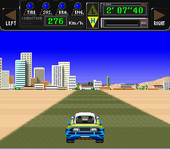Big Run (video game)
| Big Run - The Supreme 4WD Challenge | |
|---|---|
 Screenshot of Big Run | |
| Developer(s) | Jaleco |
| Publisher(s) | Jaleco |
| Platform(s) | Arcade game |
| Release date(s) | 1989 |
| Genre(s) | Racing game |
| Mode(s) | Single player |
| Cabinet | Horizontal |
| Arcade system | Dedicated Jaleco hardware |
| CPU | Motorola 68000x3 |
| Sound |
Sound CPU : 68000 Sound Chips : YM2151, OKI6295 |
| Display | Raster, 256 x 224 pixels, 3840 colors |
Big Run (ビッグラン) is a 3D rally racing arcade game released by Jaleco in 1989. The game is the first to be set in the famous Paris-Dakar rally raid which the player drives a Porsche 959, resembling that of the 1986 winner. Opponents in the game seem to resemble the Peugeot 205 T16, which went on to win in the 1987 Paris-Dakar rally, with Mitsubishi Pajeros also appears occasionally.
There are two games in the series: Big Run - The Supreme 4WD Challenge - 11e Rallye (1989) and Big Run - The Supreme 4WD Challenge - 13e Rallye (1991, Super Famicom)
The game was also ported to the Amiga and Atari ST, and is known as Big Run.
Super Famicom version
| Jaleco Rally: Big Run: The Supreme 4WD Challenge | |
|---|---|
 Cover art | |
| Publisher(s) | Jaleco |
| Platform(s) | Super Famicom |
| Release date(s) |
‹See Tfd›
|
| Genre(s) | Racing |
| Mode(s) | Single-player |
There are no Mode 7 graphics used in the game; which is rare for a Super NES game. Instead, the race proceeds in a straight line without any 360° effects to simulate turning around and going in different direction. Most of the turns are on a 30° angle; forcing the player to turn sharply to the left and to the right. At the end of the game, there is a message that says "Those who have tasted the waters of Africa will always long to be here" along with some synthesized beats. This message will play right after the "game over" screen no matter if the player wins or loses the game.

The object of the game is to travel from the cosmopolitan landscape of Tripoli, Libya to the swamp regions of West Africa (including the target of Dakar) in a rally race. Hitting various components of the environment in addition to the other rally vehicles will cause the player's vehicle to take damage. Taking too much damage will result in trouble for any or all of the vehicle's components.
There are many navigators (one female, five male) that know every crook and cranny of Africa (the signals are given by nudges to turn either left or right). In addition to this, there are many corporate sponsors (with names sounding similar to real life corporations), auto mechanics, and automobile parts to choose from as the player goes for more than 4,000 kilometres or 2,500 miles through tricky terrain. Deserts, jungles, and even darkness can astonish and even distract an unwary player. The object is to finish each leg of the rally before time runs out (failing to achieve this goal will result in a disqualification and an immediate game over - like in the real life rally circuit). Navigators help to serve a purpose by directing players safely past areas of darkness in the race. Engine parts must be replaced approximately 2,500 kilometres or 1,600 miles by a head mechanic and his/her support mechanic. Racing equipment (tires, engine, brakes) must be packed up in the vehicle; creating extra weight that slows down the vehicle's top speed rating. The goal is to have as many replacement parts as possible while keeping the vehicle as light as possible. Doing this all will be a challenge for even the best video game rally racing drivers in the world. Emergencies do not cost money to use but will cause the player to lose time on the clock while waiting for the repair truck to appear. Having no parts will eventually cause the vehicle to stall on the rally; eating up precious time until it finally runs out.
References
External links
- Big Run at MobyGames
- Jaleco Rally: Big Run - The Supreme 4WD Challenge at MobyGames
- Big Run (Commodore Amiga) at GameFAQs